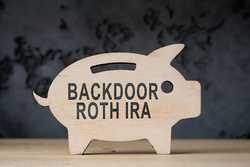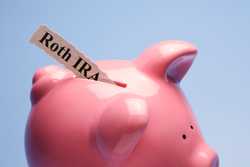- High contribution limit.
- Spouse eligibility.
- Pretax or after-tax contributions.
- Catch-up contributions for ages 50 and older.
- 401(k) loan availability.
Best Self Employed Retirement Plans of 2025


Our evaluations and opinions are not influenced by our advertising relationships, but we may earn a commission from our partners’ links. This content is created by TIME Stamped, under TIME’s direction and produced in accordance with TIME’s editorial guidelines and overseen by TIME’s editorial staff. Learn more about it.
Self-employed retirement plans are among the most powerful tax-advantaged accounts available. These plans allow solo business owners to save money for retirement beyond an individual retirement account (IRA), whether traditional or Roth. As self-employed workers are both the employee and the employer, these retirement accounts allow for substantial contributions above what a salaried worker can save through an employer plan. Navigating the available self-employed retirement plans can help freelancers and solo entrepreneurs maximize their retirement savings.
| Plan | Best for | Maximum contribution limits | Catch-up contributions | Employees included |
|---|---|---|---|---|
Solo 401(k) | Self-employed workers and their spouses | $69,000 ($76,500 for age 50 and older) | Yes | No (except spouses) |
SEP IRA | Self-employed workers with few employees who want to contribute to employee accounts | $69,000 | No | Yes |
SIMPLE IRA | Small businesses with fewer than 100 employees or freelancers | $16,000 ($19,500 for age 50 and older) | Yes | Yes |
Traditional or Roth IRA | Workers with limited self-employment income | $7,000 ($8,000 for age 50 and older) | Yes | No |
Self-employed workers and their spouses are eligible for a solo 401(k) if they have earned income and no employees. This includes side business owners with a full-time job that provides them with an employer-sponsored plan.
Participants can contribute as employees and employers, increasing the maximum annual contribution amount above a standard employer-sponsored 401(k). Plus, spouses can contribute up to the maximum, making this a robust retirement savings plan. Another benefit is the ability to borrow from the plan and pay back the loan with interest, which goes into the account.
Solo 401(k) plans require plan documents, which can add some paperwork to the opening process. Financial institutions administering these plans provide preapproved documents that business owners can use. However, a customized solo 401(k) will take additional work. The Internal Revenue Service (IRS) mandates that you file an additional form (Form 5500-EZ) when the account balance reaches $250,000.
To understand how a solo 401(k) works, think of contributing both as an employee of your company and as the employer.
The contribution limit for 2024 is $69,000 ($76,500 if the participant is 50 or older). The maximum employee deferral is 100% of earned income or $23,000, whichever is less. This is the same limit for salaried workers who participate in sponsored plans.
The employer contribution (profit sharing) of the solo 401(k) allows for an additional contribution of 25% of compensation, up to $46,000 more, totaling $69,000. The maximum compensation amount for determining employer and employee contributions is $345,000 for 2024.
Participants can make solo 401(k) contributions before tax or after tax (the latter requires a Roth solo 401(k)). Pretax contributions reduce taxable income in the tax year of the contribution and grow tax deferred like a 401(k) or traditional IRA. After-tax contributions do not reduce taxable income but grow tax free like a Roth IRA.
A simplified employee pension (SEP) IRA achieves tax benefits similar to those of a solo 401(k) for self-employed workers, but it operates like an IRA. Employees can’t defer salaried income with a SEP IRA as they can with a 401(k). Instead, they typically calculate the maximum contribution and contribute funds by the due date of the tax year’s business return, usually April 15.
A SEP IRA allows an employer to make contributions into the owner’s account if self-employed and also into other employees’ accounts. If a business owner contributes a percentage to their personal SEP IRA, they are required to make an equal percentage contribution to their employees’ SEP IRAs. Employer contributions to employee accounts are tax deductible to the employer.
A SEP IRA is not the best choice if you plan to hire employees in the future and do not want to contribute to their retirement accounts. However, it is an easily administered retirement account for solo workers. The IRS doesn’t require additional filings for large accounts, as it does for a solo 401(k).
A SEP IRA has tax advantages similar to a solo 401(k), but it doesn’t allow catch-up contributions for people age 50 and older.
The 2024 SEP IRA contribution limit is the lesser of 25% of the employee’s compensation or $69,000. Catch-up contributions do not apply to SEP IRAs.
Participants can contribute before taxes, as with a traditional IRA, or after taxes, as with a Roth IRA. However, contributions can’t be withheld from a paycheck as with a solo 401(k). Pretax contributions reduce taxable income in the tax year of the contribution and grow tax deferred. After-tax contributions do not reduce taxable income but grow tax free.
A savings incentive match plan for employees (SIMPLE) IRA is a retirement plan for small businesses with fewer than 100 employees or self-employed individuals. It is a less complex way to administer a retirement savings plan than a 401(k).
Employees can contribute pretax dollars to SIMPLE IRAs, reducing taxable income, or after-tax dollars, which grow tax free. Employers have two options for providing matching contributions to eligible employees earning more than $5,000 per year.
Employees, including a single self-employed business owner, may contribute up to $16,000 to a SIMPLE IRA in 2024. The catch-up contribution limit for those 50 and older is $3,500.
In addition, employers must contribute to their employees’ accounts. They can choose a match of 1% to 3% of an employee’s contributions or a nonelective contribution of 2% of their salary (limited to $345,000) when the employee does not contribute.
SIMPLE IRAs follow the tax-advantaged rules of traditional IRAs and Roths. Pretax contributions grow tax deferred. After-tax contributions do not reduce taxable income but grow tax free.
When a participant reaches age 59½, penalty-free withdrawals become allowable. However, the IRS penalizes SIMPLE IRA early withdrawals at 25% if made within two years of the first SIMPLE IRA contribution. After two years the penalty decreases to 10%, as with other IRAs. Exceptions may apply.
Self-employed workers do not need special accounts to save for retirement, as traditional and Roth IRAs are always available to them. If you’ve recently started a side business or left your full-time job, focus on maxing out individual IRAs for you and your spouse first. Only when you’re generating enough surplus income to invest more into retirement should you consider opening one of the above self-employed retirement accounts.
The 2024 IRA contribution limit is $7,000, plus a $1,000 catch-up contribution for people age 50 and older.
Traditional IRA participants contribute pretax dollars, reducing taxable income, and contributions grow tax deferred. Roth IRA participants contribute after-tax dollars, which don’t reduce taxable income, and contributions grow tax free.
Traditional IRA participants can withdraw funds penalty free after age 59½. The IRS taxes traditional IRA distributions as ordinary income. A 10% early withdrawal penalty may apply for withdrawals made when a participant is under 59½. Required minimum distributions (RMDs) start when participants reach age 73.
Roth IRA participants can withdraw contributions tax free at any time. However, interest on those contributions must remain untouched until age 59½ to avoid penalties. After that Roth IRA withdrawals are tax and penalty free as long as the account has been open for at least five years. Unlike traditional IRAs, Roth IRAS are not subject to RMDs.
A traditional or Roth IRA may be sufficient if you’re a small business just getting started. However, as your self-employment income grows, allowing you to max out individual and spousal IRAs, you should open one of the self-employment retirement accounts mentioned above.
Because of higher contribution limits, high-income earners can benefit more from a solo 401(k) or SEP IRA than a SIMPLE IRA. Therefore, we recommend either instead of the SIMPLE IRA.
The SEP IRA and solo 401(k) are both tax advantaged, and solo workers can benefit tremendously with either account. Older workers, or those who intend to run their business into their 50s and expect to earn substantial income, should choose the solo 401(k) due to its catch-up contributions. However, expect a bit more paperwork when setting it up and additional tax filings if your account surpasses $250,000.
Administratively, a SEP IRA is easier to set up and maintain for self-employed workers. However, if you hire employees and want to continue contributing to a SEP IRA for yourself, you'll need to open and contribute to employee accounts as well.
Conversely, a solo 401(k) contributor can’t contribute to their account if they hire workers other than their spouse. If you plan to maximize contributions by hiring your spouse, a solo 401(k) can double your tax-deferred contributions.
Self-employed retirement plans are excellent wealth-building vehicles for solo entrepreneurs, side hustlers, and freelancers. Due to their dual roles as employer and employee, participants benefit from higher contribution limits than for salaried employees of large companies. Married coworkers can double their retirement savings through a solo 401(k), further reducing taxable income.
SEP IRAs and solo 401(k)s are good choices for self-employed workers who have no intention of hiring any employees other than their spouse. Both provide benefits for high-income earners. If you’re still unsure about what account type to choose, contact your online broker or current retirement plan custodian to receive advice for your specific needs.
These accounts have similar tax-advantaged benefits for self-employed workers. A solo 401(k) is better if you plan to make regular deferred contributions from a paycheck. SEP IRA contributions are often made as a lump sum. Workers who are 50 or older and want to make catch-up contributions should choose a solo 401(k).
A solo 401(k) is for a worker who has no employees except their spouse. A SEP IRA is easy to set up, and it serves self-employed individuals well, but it may not be a good option if the participant plans to hire employees.
A solo 401(k) and a SEP IRA are the best retirement plans for self-employed individuals. Either can benefit a solo worker, but they vary when considering adding employees.
Yes. Self-employed individuals can have employer-sponsored accounts from previous jobs, traditional IRAs, Roth IRAs, and self-employment retirement accounts all at the same time. It helps to keep them under one account provider. Consider rolling over former employer plans into a traditional IRA to simplify your finances.
Yes. Contributions to solo 401(k)s and SEP IRAs are made before the money is taxed, meaning they reduce taxable income in the tax year the contributions are made.
The information presented here is created by TIME Stamped and overseen by TIME editorial staff. To learn more, see our About Us page.



